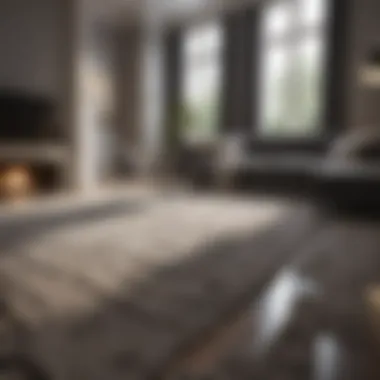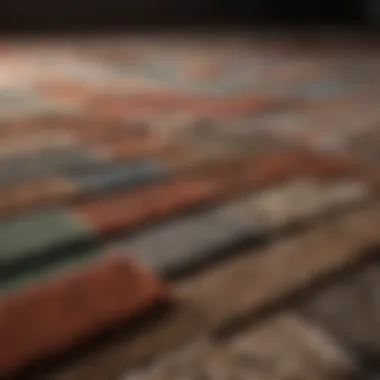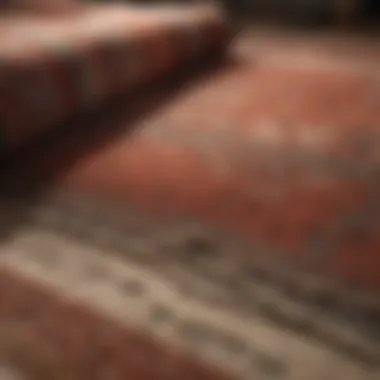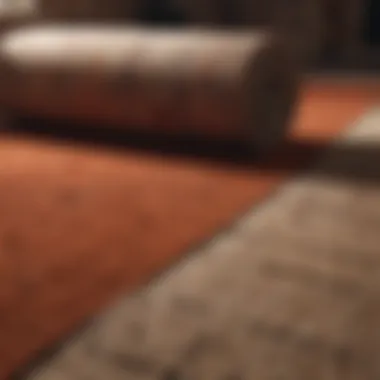Understanding Carpet Costs: A Detailed Guide


Intro
The realm of carpeting can be perplexing. With an array of styles, materials, and pricing structures, choosing the right carpet involves more than just picking a color or pattern. Understanding the cost implications is crucial for homeowners and interior design enthusiasts alike. This article delves into the myriad of factors that influence carpet pricing. From different materials—like wool, nylon, and polyester—to hidden costs such as installation and maintenance, readers will gain a well-rounded perspective by the end of the analysis.
Design Inspiration
Choosing a carpet is often the most significant aspect of home decor. A well-selected carpet can effortlessly tie a room together, enhancing its aesthetic appeal. There are numerous trends that can inspire homeowners.
Trending Styles
Current trends highlight a shift towards sustainable materials and minimalistic designs. Natural fibers, such as jute and sisal, are becoming increasingly popular due to their eco-friendly qualities. On the other hand, bold geometric patterns and texture-rich carpets inject personality into spaces.
Consider:
- Textured carpets: These add depth and richness, suitable for various styles.
- Geometric designs: Ideal for modern or contemporary settings.
- Natural fibers: Perfect for those seeking an environmentally conscious option.
Color Palettes
Color choice plays a pivotal role in carpet selection. Trends indicate a preference for muted and earthy tones, but vibrant colors can serve as focal points in any room.
When selecting colors, consider:
- Neutrals: These ensure versatility and timelessness.
- Bold colors: These can enhance rooms with specific themes or moods.
- Consider lighting: Different hues can look distinct in varying light conditions, affecting the overall atmosphere of the space.
Practical Tips
To make the best carpet choice, it is critical to think about the practical aspects involved, such as maintenance and budgeting.
Maintenance & Care
Carpet maintenance is fundamental to prolonging its life. Regular cleaning and care can prevent significant costs down the line. Here are a few maintenance tips:
- Vacuum regularly: This prevents dirt buildup and keeps fibers fresh.
- Spot clean: Address stains immediately to avoid permanent marks.
- Professional cleaning: Consider deep cleaning at least once a year to maintain appearance and hygiene.
Budgeting & Planning
Budgeting for a new carpet requires careful consideration of various expenses. It's not just about the upfront cost of the carpet itself.
Factors to include are:
- Material costs: Different fibers have different price points.
- Installation fees: Professional installation can add significantly to total expenses.
- Long-term maintenance: Weigh the costs of care and cleaning over time.
By considering all these aspects, homeowners can align their choices with their financial capabilities.
Informed decision-making is key to a satisfying carpet purchase. Understanding the scope of options and associated costs can enhance any home's decor while aligning with budget constraints.
Understanding Carpet Pricing
Understanding carpet pricing is essential for consumers who wish to make informed decisions regarding their flooring choices. Knowing how costs are determined helps shoppers evaluate quality, style, and overall value. This section addresses why comprehending carpet pricing is relevant to homeowners, interior designers, and anyone investing in carpets.
Carpet pricing is not a simple matter of knowing the sticker price. Variability in costs can arise from different factors, such as materials used, brand reputation, and even the manufacturing process. By dissecting these aspects, buyers can align their choices with their budgets, ensuring that they make purchases that not only enhance their living spaces but also offer long-term satisfaction.
Overview of Carpet Costs
The price of carpets varies widely, typically ranging from $1 to over $20 per square foot. The average cost can fluctuate based on the type and quality of the carpet.
- Basic carpets often cost less but may lack durability.
- High-end options offer luxurious qualities and longer lifespans but can break a budget.
Tips to consider:
- Measure the area to be carpeted to better estimate total costs.
- Research different outlets to find competitive pricing.
Factors that Affect Carpet Price
Several elements influence the overall pricing of carpets. A more detailed analysis of these factors can help consumers understand what they can expect to pay throughout their shopping journey.
Material Quality
Material quality plays a significant role in determining carpet prices. High-quality materials such as wool tend to be more expensive but offer durability and comfort.
Key characteristic: Wool is natural and sustainable.


Advantages: Wool carpets resist stains and maintain their appearance longer.
Disadvantages: The initial investment for wool can be substantially higher than synthetic options.
Brand Reputation
Brand reputation directly correlates to trust and perceived value in the market. Established brands often command higher prices due to their history of quality assurance.
Key characteristic: Well-known brands often emphasize reliability.
Advantages: A reputable brand may offer stronger customer support and warranty options.
Disadvantages: Lesser-known brands might provide similar quality at reduced prices, warranting careful evaluation.
Carpet Type
The type of carpet chosen significantly impacts the price range. Each type caters to specific functions and aesthetics.
Key characteristic: Carpets can be categorized into woven, tufted, and needlefelt.
Advantages: Certain types may provide specialized benefits, such as sound absorption or increased durability.
Disadvantages: Some options can be more costly based on the manufacturing intricacies involved.
Manufacturing Process
The manufacturing process influences the pricing and characteristics of carpets. Techniques such as hand-tufting require more labor and time, resulting in higher costs.
Key characteristic: Handcrafted carpets often possess individual uniqueness.
Advantages: They can last longer and may offer superior visual appeal.
Disadvantages: They are usually pricier and potentially less available in larger quantities.
Location of Purchase
The location of purchase can impact carpet prices due to factors like shipping costs and local market competition. Shopping at large retail chains could yield different pricing than local boutique stores.
Key characteristic: Online purchase options often feature competitive pricing.
Advantages: Online retailers may offer better deals compared to brick-and-mortar stores.
Disadvantages: Consumers miss out on experiencing the products in person before making a purchase.
Understanding these factors enables buyers to more effectively navigate the diverse landscape of carpet pricing, leading to more satisfying purchases.
Types of Carpets and Their Price Ranges
The types of carpets available play a crucial role in understanding costs associated with carpet purchasing. Each type carries its own price range, characteristics, and suitability for various applications. Homeowners and design enthusiasts must recognize these differences to align their selections with both aesthetic preferences and financial considerations. Whether looking for durability, appearance, or comfort, different carpet types offer diverse options to suit every need.
Woven Carpets
Price Range
Woven carpets generally fall into a higher price bracket compared to other carpet types. Their cost ranges from around $30 to $150 per square yard, reflecting the intricate weaving process involved in their production. This price point is justified by the quality and craftsmanship associated with woven carpets. A key characteristic is their longer lifespan, which adds value by reducing replacement frequency. However, the higher initial investment may pose challenges for budget-conscious buyers.
Suitable Applications
Woven carpets find their best use in formal settings such as living rooms and offices. The elegance they exude makes them a preferred choice for spaces where aesthetics matter significantly. Their intricate designs cater well to traditional and classic decor styles. However, their need for careful maintenance and potential price barrier should be considered.
Needlefelt Carpets
Price Range
Needlefelt carpets are often more economically favorable, with prices ranging from $10 to $50 per square yard. Their affordability makes them appealing for large projects or areas where budget constraints are prevalent. This range reflects the manufacturing process which utilizes synthetic fibers to create durable carpet options. Generally, they provide a practical solution for high-traffic areas, balancing cost with durability.
Durability and Use Cases
Needlefelt carpets are renowned for their strength and resilience. They are frequently used in commercial spaces such as offices, retail environments, and schools due to their ability to withstand heavy foot traffic. This durability is a standout feature, offering long-term performance. The downside includes limited aesthetic variations, which might not suit more upscale residential applications.
Tufted Carpets


Price Range
Tufted carpets typically range from $15 to $75 per square yard, placing them in a mid-range category. Their price reflects a combination of affordability and quality. The tufting method allows for a variety of styles and textures and generally offers a softer, plusher feel. This versatility makes tufted carpets widely used in homes. However, some tufted options may not possess the same durability as woven carpets.
Installation Considerations
Installation of tufted carpets can be straightforward, yet it requires careful attention to detail. Homeowners often face the choice between DIY and professional installation. Professionals may charge installation fees that range from $2 to $4 per square foot, an expense to account for in total costs. The ease of installation is a benefit, but mistakes can lead to costly adjustments and added stress.
Cut Pile vs. Loop Pile
Cost Differences
Understanding the cost differences between cut pile and loop pile carpets is essential. Cut pile carpets are generally more expensive, ranging from $25 to $90 per square yard, due to their stylistic and textural appeal. Loop pile options present a more budget-friendly alternative, ranging from $10 to $40 per square yard. The choice between these two types can impact not only the budget but also the overall aesthetic and functionality.
Maintenance Needs
Maintenance for cut pile carpets often requires more attention than loop pile. Loop pile options tend to be more stain resistant and easier to clean, making them ideal for busy households or high-traffic areas. Cut pile, while softer and visually appealing, may show wear more quickly. This distinction is a vital consideration for homeowners aiming to balance beauty with practicality.
Installation Costs
Understanding installation costs is crucial when it comes to carpets. The initial price of the carpet itself is only part of the overall investment. Homeowners must consider how they will go about putting the carpet into their space. This section will explore the options available and the costs associated with each.
DIY Installation vs. Professional Installation
For some homeowners, the idea of saving money by installing carpet themselves is appealing. A DIY approach can indeed reduce costs, as labor fees can be significant. However, it's essential to recognize that this option requires a certain level of skill and understanding of the tools involved. Not all individuals feel comfortable tackling this project. The outcome may vary based on experience, and there is a risk of mistakes that could increase the overall cost.
On the other hand, professional installation guarantees a level of skill and precision that can be beneficial. Professionals know how to handle various types of carpets and can anticipate problems that inexperienced installers may overlook. While this method is typically more expensive, it often leads to better results and reduced frustration. It can be worth the extra investment for those who are not experienced in home improvements.
Average Installation Fees
When looking at average installation fees, they can vary widely based on location and the complexity of the job. Special considerations like room shape and existing flooring can also influence these costs significantly.
Regional Variations
Regional variations contribute greatly to installation costs. Different areas have different cost of living standards, and this affects how much labor will cost. For example, installing carpet in major metropolitan areas like New York City or San Francisco may cost significantly more than in smaller towns. The demand for skilled labor in these regions often drives prices higher. Additionally, local competition among installers can also impact fees.
A unique feature of these regional variations is that they reflect the economic conditions of a specific area. Higher demand typically leads to higher prices, but in a saturated market with many providers, costs might be lower. This aspect can benefit homeowners, as they may find competitive rates in some regions.
Company Reputation
Company reputation plays a vital role in determining installation costs. Well-established companies often charge a premium due to their experience and proven track record of quality work. Homeowners tend to trust companies with a positive reputation, believing they will receive better service and results.
A unique feature of company reputation is the customer reviews and feedback they accumulate over time. These testimonials can provide insight into the reliability and quality of service offered. However, relying solely on reputation can also have disadvantages. Sometimes, less-known or newer companies may provide equal or better quality at a lower price.
When selecting a company for installation, it is essential to balance reputation with overall cost and the quality of previous work.
Maintenance and Lifespan of Carpets
The maintenance and lifespan of carpets are essential topics for any homeowner or design enthusiast. Understanding how to care for carpets can significantly impact their durability and aesthetic appeal. Proper maintenance not only extends the life of the carpet but also keeps it looking new and fresh. Potential buyers should be aware that neglecting maintenance can lead to premature replacement costs, further straining a budget.
Cleaning and Upkeep Costs
Understanding Cleaning Techniques
Various cleaning techniques exist to maintain carpets effectively. Regular vacuuming is a fundamental practice. It removes dirt and debris, preventing it from embedding into the fibers. Steam cleaning is another method that can sanitizes carpets well. This technique uses hot water and cleaning solutions to eliminate deep-seated dirt.
The key characteristic of these techniques is their ability to prolong the life of carpets. Regular upkeep reduces the buildup of allergens and stain-causing agents. It is a beneficial choice for maintaining both appearance and hygiene. However, steam cleaning may require professional services, thus incurring extra costs. Hence, cost-effective solutions should be considered, depending on a homeowner's specific situation.
Frequency of Professional Cleaning
The frequency of professional cleaning is another factor in carpet maintenance. Most experts recommend having carpets professionally cleaned every 12 to 18 months. This regularity helps remove deeper dirt that casual cleaning might miss.
By adhering to this schedule, homeowners can ensure carpets remain in optimal condition. Despite the initial expense, it can save money in the long term, as it can extend the overall lifespan of the carpet. However, deciding on how often to clean can depend on several factors, such as foot traffic and the presence of pets, which may necessitate more frequent cleaning.
Longevity and Durability
Materials and Their Lifespans
Different materials have varying lifespans, and knowing this is crucial for buyers. For instance, nylon carpets typically last longer than polyester versions. Wool carpets, while more expensive, possess exceptional durability and resilience. The key characteristic of these materials is their unique composition, which offers different advantages.
Selecting a high-quality material can mean lower replacement costs over time. While upfront costs might be higher, investing in durable materials can result in savings in maintenance and replacement. The unique feature of knowing material lifespan is understanding which types suit your home's environment and usage patterns.


Impact of Foot Traffic on Carpet Life
Foot traffic is a significant factor affecting the lifespan of carpets. Homes with high foot traffic experience more wear and tear compared to those with less. The key characteristic here is that carpets in busy areas, like entranceways or living rooms, may require more robust materials designed to withstand constant use.
This understanding can assist homeowners in making informed choices about where to install specific carpet types. Rubber-backed or looped carpets, for example, can handle more foot traffic. However, opting for a lower-quality carpet in high-traffic areas can lead to quicker deterioration, increasing long-term costs.
Regular maintenance alongside informed choices about material and traffic can greatly enhance the lifespan of your carpet.
Sustainable Carpet Options
As environmental concerns continue to shape consumer behavior, the demand for sustainable carpet options has increased significantly. Homeowners and designers are beginning to recognize the importance of choosing materials that have a minimal impact on the environment. This section delineates the significance of sustainable carpets, their materials, and the cost considerations associated with them.
Eco-Friendly Materials
Sustainable carpets predominantly rely on eco-friendly materials, which are crucial for reducing the carbon footprint of flooring. These materials often include renewable resources, such as bamboo, wool, and organic cotton. Manufacturers of sustainable carpets pay careful attention to sourcing their raw materials to ensure they are produced ethically and with minimal waste.
- Bamboo: Known for its rapid growth, bamboo regeneration occurs naturally without the need for pesticides. This makes bamboo an excellent choice for eco-conscious consumers.
- Wool: Naturally biodegradable, wool provides durability and insulation. Sheep can graze on these plants, which contributes to sustainable agriculture practices.
- Recycled Fibers: Some carpets utilize fibers made from recycled plastics, diverting waste from landfills while creating functional and stylish flooring options.
Using such materials not only benefits the environment but often results in better indoor air quality, as these carpets typically contain fewer volatile organic compounds (VOCs).
Cost Considerations for Sustainable Options
When selecting sustainable carpets, cost can be a significant factor. Buyers might initially find that eco-friendly options come with a higher price tag compared to conventional carpets. Here are key aspects to consider regarding costs:
- Initial Investment vs. Longevity: Sustainable carpets may have higher upfront costs, but their durability often leads to long-term savings due to lower replacement frequency.
- Installation Fees: Certain sustainable materials may require specific installation techniques or experienced professionals, potentially increasing labor costs.
- Availability and Sourcing: Depending on location, eco-friendly materials might not be as readily available, affecting pricing fluctuations.
While the purchase price of sustainable carpets may be higher, the long-term environmental benefits, along with potential savings on energy and maintenance, warrant consideration.
Consumers are encouraged to weigh both the ecological and economical implications of their flooring choices. By investing in sustainable materials, one contributes to a healthier planet while enhancing their living space.
Warranty and Return Policies
Understanding warranty and return policies is crucial for consumers when investing in carpets. These policies not only protect your investment but also provide peace of mind in case issues arise with your purchase. As one navigates the abundance of carpet options in the market, being informed about these safeguards can significantly influence one’s decision-making process.
Understanding Carpet Warranties
Warranties for carpets generally encompass several aspects, including the duration of coverage, types of damages covered, and specific conditions for making a claim. Most carpet manufacturers offer warranties that range from 5 to 25 years. This variation typically reflects the quality of the material and its expected longevity.
When analyzing warranties, it is essential to note the following points:
- Types of Coverage: Some warranties cover stains, wear, and manufacturing defects, while others may exclude common concerns.
- Pro-Rated Terms: Many warranties start full but gradually decrease in value, meaning the replacement cost you might get as years pass could be less than the initial value.
- Maintenance Requirements: Failure to adhere to the specific cleaning or maintenance guidelines can void warranty coverage. This includes proper cleaning methods and frequency.
Knowing the particulars of a carpet warranty is invaluable. A comprehensive warranty can save money by covering repairs or replacements, which is especially important for high-traffic areas.
Return Policies and Consumer Protection
Return policies establish the framework of protection for consumers after their carpet purchase. Since carpets are a substantial investment, understanding the return process is key for buyers. Most retailers provide a return window ranging from 30 to 90 days.
Consider these important aspects regarding return policies:
- Return Conditions: Many retailers require the carpet to remain in unused condition, while others might allow returns if the carpet is cut to fit during installation.
- Fees and Charges: Some retailers impose restocking fees. It is wise to account for these potential costs when making a decision.
- Paperwork Necessity: Keeping track of receipts and warranty documents is vital. Many stores will not process returns without the original purchase documentation.
"A thorough grasp of warranty and return policies is just as important as choosing the right carpet material."
For a more comprehensive guide on warranties and consumer protection, consider reviewing resources on Wikipedia and Britannica.
By prioritizing warranty and return options, you position yourself more favorably, ensuring your investment is secure, allowing for a more enjoyable and worry-free home environment.
Epilogue and Recommendations
The Conclusion and Recommendations section serves as a vital waypoint in understanding the comprehensive journey through carpet pricing. It crystallizes essential insights derived from previous sections, ensuring that readers, particularly homeowners and interior design enthusiasts, grasp critical information efficiently. This part synthesizes the discussions on various factors affecting carpet costs, types, installation nuances, and maintenance strategies.
When considering carpet investment, recognizing the implications of pricing on lifestyle and environment is fundamental. A well-chosen carpet not only enhances visual appeal but also aligns with a homeowner's financial goals. Moreover, understanding warranties and return policies enhances buyer confidence, thus reinforcing the purchase decision. It emphasizes the synergy between choice and budgeting while compelling potential buyers to think actively about their selections.
Recap of Key Points
In summary, various factors play an integral role in determining carpet costs, including:
- Material Quality: The type of fiber used can significantly influence the price.
- Brand Reputation: Some brands command higher prices due to their established trustworthiness and quality.
- Carpet Type: Different types of carpets, like woven or tufted, come with distinct price points and characteristics.
- Installation Requirements: Whether choosing DIY or professional installation can alter the overall expenditure.
- Maintenance Considerations: Acknowledging upkeep can assist in understanding long-term costs.
By reviewing these points, buyers are provided a clearer framework for their decisions.
Final Advice for Buyers
As potential buyers prepare to select carpets, a few practical considerations can be immensely beneficial:
- Assess Budgets Accurately: Set a realistic budget that accounts for not just the purchase price but also installation and maintenance.
- Research Material Options: Understand the distinct qualities of different materials. Natural fibers like wool may be costlier upfront but may save on maintenance in the long run.
- Consider Use Cases: Evaluate where the carpet will be used. Areas with high foot traffic require durable options.
- Read Reviews: Seek out information and feedback on product performance and customer service from various platforms like Reddit or Facebook.
- Inspect Warranties: Familiarize yourself with each product’s warranty. This can offer peace of mind and protect your investment.
By following these guidelines, buyers can navigate their choices more confidently. Ultimately, a deeper awareness of carpet pricing and its associated nuances empowers homeowners to enhance their living spaces effectively.















